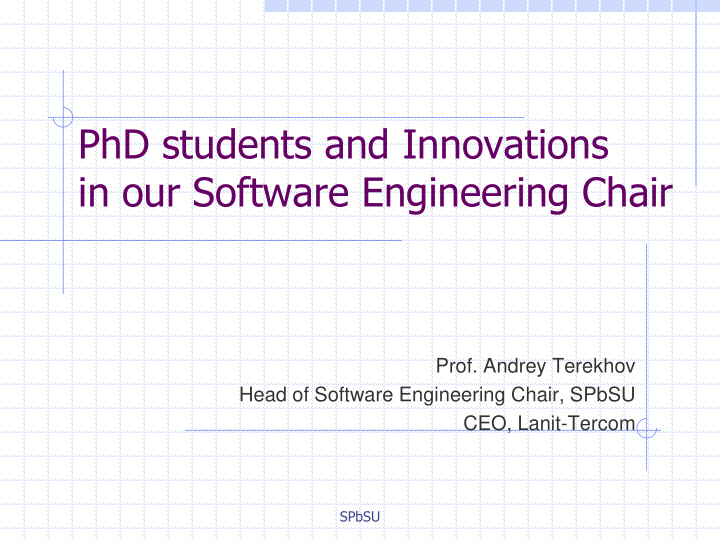



PhD students and Innovations in our Software Engineering Chair Prof. Andrey Terekhov Head of Software Engineering Chair, SPbSU CEO, Lanit-Tercom SPbSU
Introduction Pure mathematician needs only a sheet of paper and a pencil, while programmer needs computer. When I was a student it was rather expensive even to rent a computer time not to buy it itself. Software Engineering is impossible without team of professionals and a lot of time (and money!). At the same time software engineer creates the product or technology that could be sold. We teach our students (in accordance with international standards) and PhD students not only to create programs but how to sell them or to find investors to fund the development process. SPbSU
The Born of our Team 1968, Dr. Grigory Tseytin organized a group of students and teachers on the Faculty of Mathematics and Mechanics of LSU (Leningrad State University). The main goal – new programming language Algol 68 implementation (the investigation had began before official Report was published). 1974, after publishing of Revised Report on the Algorithmic Language Algol 68 the research was finished and practical job began. Weekly business trips to Moscow. Night shifts, heavy duties, I had to lead our team. 1976, we finished work on the translator of Algol 68 for ES EVM (IBM/360). It was the 1 st Algol 68 translator in the USSR. My PhD thesis “ Methods of effective object code synthesis ” . SPbSU
Some of the “ old ” PhD theses 1986, Tobias Fischer (GDR) “ The development of software technology with specific languages based on Algol 68 ” . Algol 68 was one of the first languages with the possibility to create new specific languages for different areas without implementation of new translator. Tobias investigated these possibilities for tasks of account service, mathematical physics and so on. 1987, Nikolay Fominykh “ Elbrus autocode interpreter for ES EVM ” . Elbrus was a Soviet original HLL-computer but we had to wait for more than 5 years before its production. Our interpreter was so popular that there were a lot of users even after production of Elbrus. 1987, Natalia Datsun, “ Tools for automatic design of computing devices based on the chip set ” . There was new specific language created for description of the popular at that time chip sets. SPbSU
Some of the “ old ” PhD theses - 2 1987, Arcady Popov “ Methods of Ada programming language implementation ” . First Ada implementation in the USSR firstly for ES then for PC. 1991, “ The technology for development of real-time embedded systems ” , my habilitation thesis. We have created more than 25 new specific languages and translators and understood that graphical tools are very useful for software development. 1993, Anna Bulyonkova “ Data management in embedded systems ” . This work was about data recovery methods for real-time systems. 1995, Vladimir Parfenov “ Embedded systems ’ software design and implementation using object-based approach ” . Object-oriented approach was not wide spread in Russia that time. We have created new effective implementation of computational process when objects worked with local data and then transferred results to next objects. SPbSU
Some of the “ old ” PhD theses - 3 1995, Yulia Lavrova “ Code-generation part of the translator development methodology. Set of ALGOL 68 translators as example ” . Our basic translator of Algol 68 to ES was written on Algol 68 itself. Yulia have made effective code-generation for PEVM. 2002, Len Erlikh (USA) “ Reengineering technology for legacy software systems ” . Working with North Carolina companies on tools development for software reengineering we ’ ve achieved an impressive result. 3 times our products were named as best in the world in Legacy Understanding and Legacy Transformation areas by Gartner Group. 2004, Dmitry Boulytchev “ Embedded systems ’ prototyping based on microarchitecture description ” . We are working on CoDesign technology for more than 15 years. Dmitry had created HaSCoL (Hardware and Software CoDesign Language) which is used for design of industrial chips. 2005, Alexander Ivanov “ Data oriented information systems ’ automatic generation ” . With the help of our graphical technologies we have created software for universities. SPbSU
Industrial application After “ Perestroyka ” we had a lack of investment from our government. 1991, Tercom foundation. Scientific-intensive tasks. 1991-1998, Collaboration with Italtel – first ATM switch in Europe. We could not receive contracts for translators but we could make reengineering. Collaboration with companies from Nothern Carolina- SEER, then Relativity Technologies and Blue Phoenix. 40 master theses and 3 PhD theses on reengineering. SPbSU
Some of the “ new ” PhD theses Timofey Bryksin, QReal metatechnology. DSLs are better than universal programming languages for some tasks. We are working on metatechnology to create new DSLs with graphical editors, repositorium, target code generators and so on Yuri Litvinov, Qreal:Robots. Programming for robots is one of the most popular ways to teach programming. New language for Lego Mindstorms robots ’ program development. Roman Luchin, New robotics construction set. Lego Mindstorms is oriented to pupils of 5 th -6 th classes, it ’ s hard to solve complicated tasks. New construction set will have powerful controller and wide set of sensors and details. SPbSU
Some of the “ new ” PhD theses - 2 Valentin Onosovsky, Ubiq Mobile. Universal platform for development of complicated client-server mobile services. Alexander Pimenov, Computer stereovision. 2 main directions – automotive industry (road obstacles recognition) and consumer electronics (gesture recognition). Konstantin Amelin. Multiagent network control for the group of UAVs (Unmanned aerial vehicle). We have already received 2 grants from FASIE and found an investor. SPbSU
Recommend
More recommend